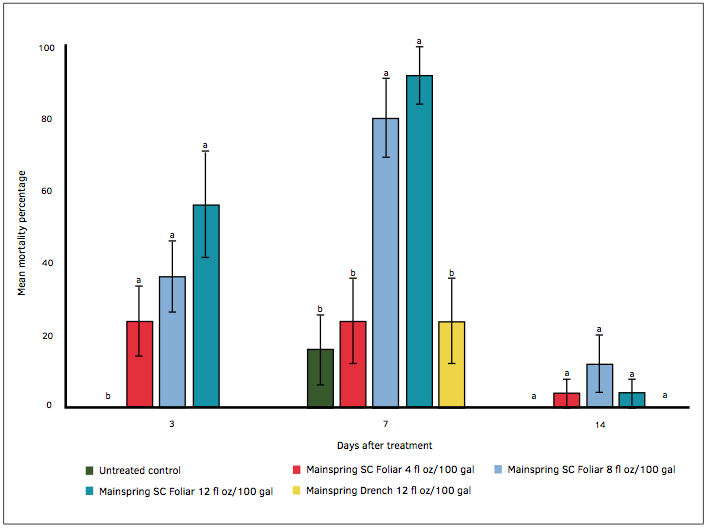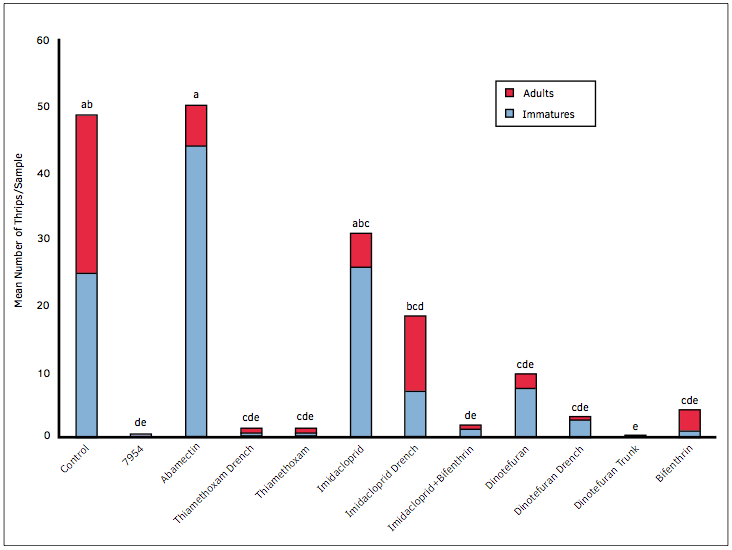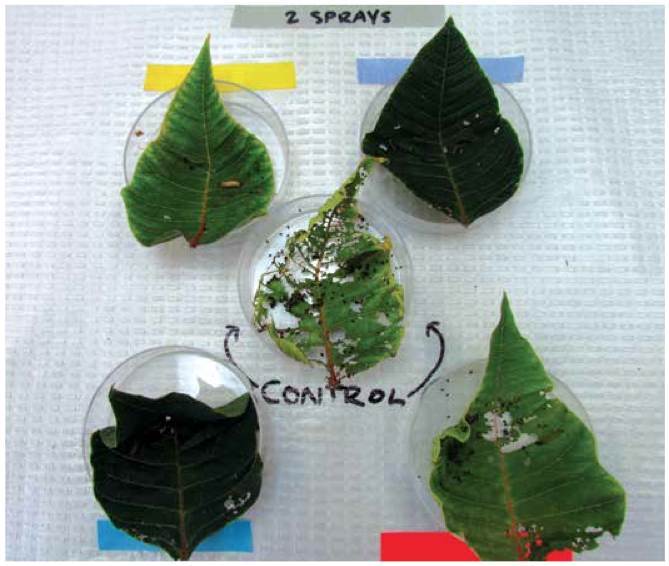
Extension Research and Education Helps Growers Battle Invasives
For those who are unfamiliar with my work, I am the nursery and floriculture advisor for San Diego and Riverside counties in southern California. My duties include conducting extension research and education programs with emphasis in improving production and viability of the floriculture and nursery crop industries.
Three staff research associates and two agricultural technicians support my work, and most are housed at the Center for Applied Horticultural Research located on the property of Altman Plants in Vista, California. Bryan Vander Mey is the research associate in charge of conducting the day-to-day business of my research projects. Loretta Bates has assisted our efforts against the Diaprepes root weevil and is now in charge of agricultural water quality education. Lea Corkidi assists our project with pesticide trials, nuisance insect research and reports. Lorin Lima has been conducting collaborative research with Lance Osborne from the University of Florida and Arnold Hara from the University of Hawaii. Lastly, Marianne Whitehead is an agricultural technician responsible for supporting multiple projects and was assigned to testing biologicals or organic products against the Asian citrus psyllid, which is having a significant impact on the citrus nursery industry here in California.
Our research projects are supported by many private and public organizations including the California Association of Nurseries and Garden Centers, the California Cut Flower Commission, California Association of Pest Control Advisors, the California Department of Food and Agriculture (CDFA), USDA Animal Plant Health Inspection Service (APHIS), USDA Agricultural Research Service (ARS), and other state and federal grants.
Additionally, we are supported by the ag chem industry to assist in data collection for pesticide registration in California and nationally. We routinely screen new pesticides for control of major pests of ornamental plant production including aphids, caterpillars, leafminers, mealybugs, mites and thrips.
RECENT TRIAL AGAINST THE EUROPEAN PEPPER MOTH
Recently, we conducted a trial using cyantraniliprole (Mainspring SC, Syngenta Crop Protection LLC) against immature stages of the European Pepper Moth (EPM) Duponchelia fovealis (Zeller). Our intention was to determine the efficacy of the product against early instar larvae on potted poinsettia (‘Prestige Early Red’) and to determine if cyantraniliprole had an effect on feeding by exposing larvae to treated leaves in small experimental cages. The trials were conducted at the Center for Applied Horticultural Research.
Plants (five replicates/treatment) used in the trial were grown in 1-gallon containers, treated with different rates and modes of application of Mainspring SC, and then infested with five third instar European pepper moth larvae. The number of adults that emerged from each treatment group was monitored for four weeks after infestation. We also collected treated leaves at different dates and exposed them to single larvae in bioassay small plastic petri dishes and observed mortality and feeding behavior for 48 hours.
In short, we observed 100 percent mortality or no emergence from treated plants during the length of the trial with the exception of a single adult found on plants treated at the lowest rate of 4 fluid ounces per 100 gallons. In our bioassays, we observed good mortality to larvae exposed to leaves treated seven days earlier with Mainspring at 8 and 12 fluid ounces per 100 gallons (Figure 1). Mortality was not evident, however, for the rest of our bioassays, but it is known that this product causes feeding cessation and eventual death as we observed in our whole-plant trial. A feeding behavior change was evident in our bioassays (Figure 2) where we see that untreated control leaves are severely damaged and treated leaves have little damage, if any. We did observe a bit more damage to leaves that were treated with the drench application.

EXTENSION EDUCATION
My responsibilities include the education of the local ornamental plant producers about best production and management practices in order to maintain viability and profitability of the industry. To that end, I conduct numerous workshops, seminars and other training locally and many times the training occurs in the conference room at the Center for Applied Horticultural Research.
Many of the presentations that I have given and short demonstration videos are located under the Resources tab on my website, http://ucanr.edu/sites/floriculturenursery/. Additionally, I contribute to UCNFA News, which is an archived, periodic publication focusing on current issues and new research in subject areas of interest to the nursery and floriculture industry, http://ucanr.edu/sites/UCNFAnews/, and other popular press magazines and newsletters.
AN EXAMPLE OF ADDRESSING A MAJOR ISSUE
One of the most impactful issues in the ornamental plant production industry is the consistent influx of invasive pests and the regulatory hurdles required to continue to process and ship ornamental plants and plant parts.
Those of us who work in an area of intense nursery and greenhouse production are recruited to assist growers and regulators in providing solutions to invasives. As such, colleagues across the country and I have been involved in numerous technical working groups to address these issues. The list is long that it is hard to list them all, but we have conducted research on the following invasives: the serpentine leafminer, various biotypes of the sweetpotato whitefly (A, B and Q), glassy-winged sharpshooter, Diaprepes root weevil, European pepper moth, Asian citrus psyllid, Tipu psyllid, Myoporum thrips, aloe aphid and mealybug, bamboo mealybug, agave mealybug, light brown apple moth and many more. The following is a brief example of how the invasion of the Myoporum thrips was addressed.
Klambothrips myopori (Mound and Morris) is primarily found in its home range on Myoporum laetum in New Zealand. It was first observed in southern California in Orange County in 2005 and later in Hawaii in March 2009. The California Department of Agriculture quickly assigned it a Q rating (potentially serious pest, but not a known pest of agriculture), and at first, they attempted to regulate the nursery industry and eradicate the pest in landscape plantings.
We began to work closely with the agricultural commissioner’s offices in several counties, but resources were lacking, and over time Myoporum in landscape plantings and nurseries along coastal California became heavily infested with thrips. A decline in the aesthetic quality and death of mature plants was a common occurrence. Because the thrips became widespread and no further efforts to eradicate this pest were attempted, the environmental horticulture industry was left to answer this new threat on its own.
We decided to address the issue as best as we could with little funding dedicated to the efforts. A review of the scientific literature showed us that little was known about this insect and submitted samples determined that this was a new undescribed thrips species. This exposed our first problem; we knew nothing about the life history of this pest and possible management solutions.
Damage to Myoporum by this thrips species is characterized by gall-like symptoms and distortion of new leaves. Terminal growth can be severely stunted and leaf curling or folding with thrips populations within the folds is common. This characteristic is similar to Cuban laurel thrips, Gynaikothrips ficorum Marchal, on Ficus species in that reaching the populations within the folds with pesticides can be problematic. When damage is persistent on terminal growth, plant death will occur.
We conducted life history studies and determined that this thrips species follows the life history of the Cuban laurel thrips very closely. There are two nymphal stages and two pupal stages 0 prior to the adult stage. All early stages are white to yellowish in color and the adult is black. Eggs and all stages
of Myoporum thrips can be found in the twisted deformed terminal growth. The minute pirate bug, a natural enemy of the thrips, was commonly found in our samples, but does not reduce damage.
Efficacy trials demonstrated that new growth could be protected with continuous applications of common pesticides such as the pyrethroids, carbamates and organophosphates. In addition to the broad-spectrum pesticides, terminal growth can be protected for longer periods of time by applying the neonicotinoids
(Table 1) as a drench application or dinotefuran as a trunk application (Figures 3 and 4). Effects can be seen rapidly with dinotefuran and thiamethoxam, but it will take more time when applying imidacloprid. Single applications in the spring and in the fall will most likely protect plants through most of the year. Drench applications of dinotefuran (also as a trunk application), thiamethoxam and the combination product with imidacloprid plus bifenthrin work very well in significantly reducing existing infestations. In addition, we have noted significant recovery of the plants two months following applications.

NEW RESEARCH FOCUS
Our research team has received funding to begin a new effort that is a continuation of research initiated by Arnold Hara at the University of Hawaii. Our goal is to replicate the hot water treatment container that is used in Hawaii to eradicate endemic and invasive pests in ornamental plant production.
Although plants treated in this manner in Hawaii meet phytosanitary requirements in California, hot water treatment of ornamental plants is not practiced in California. The preferred methods for eradication of arriving invasives or nursery cleanliness standards are pesticide applications or plant destruction, which pose undue economic burden on the producer. Potentially, pesticide applications can pose an unnecessary impact on our environment depending on the magnitude of the eradication effort for some pests.
This research project is collaborative between local and state regulatory agencies, universities and cooperating growers. Our research team includes Dustin Meador from the Center for Applied Horticultural Research, and Cheryl Wilen, Ramiro Lobo and me from UC Cooperative Extension in San Diego, California. Meador will conduct water quality studies during our experiments. Wilen will conduct plant safety studies, and I will conduct pest management studies. Ramiro Lobo is an agricultural economist and will conduct an economic analysis of the study.
In conclusion, we have an active research team in southern California that addresses the most pressing needs of the ornamental plant production industry. The resulting information is distributed through various media and presentations to local growers and beyond. You are welcome to visit us if you are in the area.



 Video Library
Video Library 




















